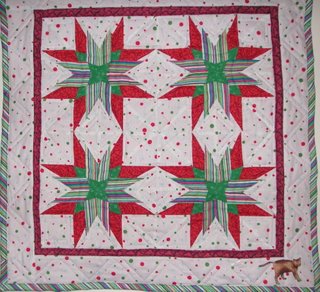Paper foundation pieced blocks usually surprise me. When I chose the fabric I have an idea what I'm going to accomplish but my sense of color is wobbly -- I'll write about that another time, maybe tomorrow -- so that I'm never quite sure just how a block is going to work until I see it done. Probably people with really good color sense will say something like "you poor handicapped schmuck". I am, both handicapped and a bit of a schmuck about how colors are going to work together -- I like to use commercial fabrics rather than hand dyes -- I really can't dye in my little NYC apartment. I love accumulating a stash and love pulliing out the fabrics I think are goiing to work. I'm often wrong.
For the past couple of years I've been making stars from Carol Doaks' book of 50 state stars. She shows them in groups of four on each page so I decided to make a number of "quartets" that would, with borders become wall size quilts. At the beginning of this entry is one of them, I'm not sure what number but it was in my digital album and demonstrates a "quartet". I just finished the first star of #14, I think. I don't have a picture of it yet because I'm contemplating whether I like it enough to continue with the background fabric I'm using -- a Hoffman geometric print with a black background that I like and have had a long time. Like many Hoffman fabrics it has its own strong pesonality which may be too assertive. The geometric print colors are greyed and the fabrics in the fairly complicated star are brighter.
I couldn't know what it would look like before I had one star done. Right now it's across the room, pinned to the black sofa. I've been myopic since I was 12. Long ago I discovered that with my glassses off the distracting patterns become fuzzy and the balance of colors pops at at me -- I'm surprised I've never heard this as a "tip" in any magazine. In my small-ish apartment I have no design wall so things lie on my black sofa.
I contemplate them from across the room. I do not complain about lack of space. Many years ago I heard Paula Nadelson speak -- about her complex quilts mainly -- but she mentioned her Bronx apartment shared with family and very crowded with her fabric stash. If she can accomplish those astonishing quilts in such a cramped space, I cannot bring myself to complain about lack of space-- tho' I dream A LOT about a studio.
 This is the most recently completed quartet. It's so bright I'm almost embarrassed by the triteness of the colors -- I call it "Christmas in August Star". I probably over reacted by chosing black print background for the new one. I found I had a stripe in my stach that had the same colors as the print only brighter. Then I chose the other fabrics of the star from the bright spectrum. On the surface this is all very clever and ought to work. Maybe it does ... I need a cople days to decide. Part of the problem is that I generally find cleverness a very bad route to take. I don't trust my own cleverness.
This is the most recently completed quartet. It's so bright I'm almost embarrassed by the triteness of the colors -- I call it "Christmas in August Star". I probably over reacted by chosing black print background for the new one. I found I had a stripe in my stach that had the same colors as the print only brighter. Then I chose the other fabrics of the star from the bright spectrum. On the surface this is all very clever and ought to work. Maybe it does ... I need a cople days to decide. Part of the problem is that I generally find cleverness a very bad route to take. I don't trust my own cleverness.In fact, I don't like cleverness in anything except cocktail party chatter. It's wonderful how delightful people become after a martini. I dislike clever novelists like Tom Robbins and clever playwrights or screen writers and I've never liked stand up comics. I don't like clever quilts either or other kinds of art. [In the spirit of full disclosure, I will admit that I'm not really clever and when I try to be it feels hollow so, sour grapes?]
I think in general cleverness is mental laziness. My theory is that a smart children find that by being clever their friends laugh at their jokes and their grandparents tell them they are the smartest kids in the whole world and they become addicted to their cleverness which was also appreciated by teachers who are so starved for anything at all sparkly in the classroom that they gave the clever kids a lot of positive feedback too. So they skated cheerfully along and some of the cleverest are making lots of money in ad agencies and glossy magazines and Hollywood. They were never challenged to really think about much.
Now that's not always true, I'm thinking about Dorothy Parker who was very, very clever -- but her cleverness was always in service of her very acidic view of life. That is where cleverness works best -- to display an ironic and sarcastic understanding of how things really are and work. Oscar Wilde was probably the cleverest writer ever, I beleieve he truly saw society's foibled and stupidities and pointed them out mercilessly, even compulsively.
Major digression, huh? With that I should pack it in for today.







No comments :
Post a Comment